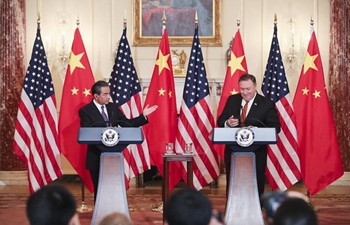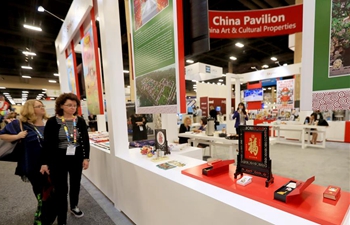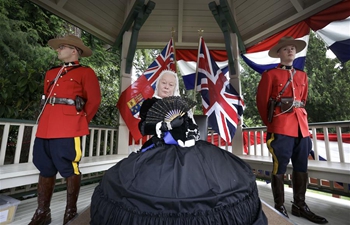by Xinhua writers Wang Wen, Zhang Mocheng
NEW YORK, May 24 (Xinhua) -- New immigrants in the United States always grapple with the duality of cultures and identities, but few of them can express their feelings like anticipation, agony, pride and compromise in such an articulate way like Chen Zhen and Ma Lin do.
In their newly-released album, the award-winning composer Chen explores new possibilities by combining the sounds of traditional Chinese musical instruments with Western ensembles. Ma plays the pipa, a pear-shaped fretted instrument and is the protagonist in the recording who tells her life story as a new immigrant in New York.
The album's name, "On & Between," refers to the uncertain status of those in an immigrant community and calls on listeners to attach great importance to the value of ethnic and cultural diversity in the United States.
The album, released on May 11, was immediately recognized by music circles and applauded by many listeners.
Two weeks before the album was officially released, music streaming site Spotify included "Lullaby" from the album in its list of classical new releases. Up until now, the album has attracted over 50,400 monthly listeners.
The album also won a gold medal at the Global Music Awards, an international music competition which celebrates independent musicians.
TRIBUTE TO CHINESE IMMIGRANTS
Chen said the album is a musical tribute to Chinese immigrants like himself, who fought hard to adapt, survive and discover themselves in a foreign country.
The ten pieces of music in the album follow a chronological order.
In the first piece called "Arrival," the rolling figures on the piano and the long phrases on the cello are combined to evoke the gradual landing of an airplane and an unfolding new life. The melody carried by the pipa expresses a tempered feeling of excitement and fear led by anticipation of the future and nostalgia for the past.
The second piece, "Good Morning, the City," is a piece about resolution and hope. The bright tone of the oboe is the voice of hope, while the roundness of the cello's sound stands for the warmth of the sun. The music describes a scene in which the protagonist wakes up basking in the sunshine and opens the window, taking in the view of New York City.
The several pieces that follow reflect the loneliness, bitterness and homesickness of a new immigrant, and the fight against social institutions.
The second half of the album looks at the more enjoyable moments of life as the protagonist becomes accustomed to life in a foreign country.
In "Lullaby," the tightness of the performance of the string quartet forms a solid foundation that supports the music's progression and the performance of the pipa, in the same way that a group of friends supports a new arrival.
U.S. LISTENERS LOVE IT
Chen sees his mission as bringing the East and the West closer together in sensibility and music through composition and performance.
The new album is part of his efforts to introduce traditional Chinese music and instruments to the Western world.
In Chen's philosophy, to make an ancient Eastern instrument such as the pipa -- which boasts more than two thousand years of history -- accessible to Western listeners, one has to compose pieces that Westerners are accustomed to while also making the timbre of the instrument stand out.
He did exactly what he said, and won heartfelt praise from the audience after an intimate live concert held on Sunday.
"The way the composer combined the Western elements with the pipa was just fascinating. I would love now to have my students see this instrument and hear it," said Lydia Kontos, director of the Kaufman Music Center.
"It's just a whole other dimension and when you think of something that isn't isolated but can blend with Western music, it then becomes ... even more exciting," Kontos added.
Kerri Kearney, who was also in attendance, said she had seen a pipa as a child at her grandfather's house but had no clue what it was.
"Tonight, it was a wonderful experience. It just seems to make it come to life," said Kearney.
Like Chen, Ma felt the responsibility of introducing the instrument to the world.
The use of saxophone and drums in the piece "Walk on the Fifth" and the performance of Blues music were a little adventurous for her.
"It came as a nice surprise when I realized that the pipa could be used with Western instruments that are so different from it," Ma said.













